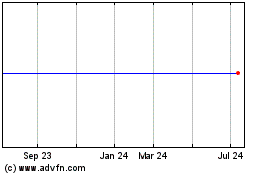High-end chain bets shoppers will pay for specialty items, as
the company expands
By Heather Haddon and Shibani Mahtani
CHICAGO -- Whole Foods Market Inc. is betting that shoppers in
low-income neighborhoods will pay for lavender-lemon cream pie and
locally sourced beer -- along with milk, bread and other staples --
as the high-end grocer looks for expansion opportunities.
Last month, a crush of shoppers from across Chicago's struggling
South Side attended the opening of a store in Englewood, with many
praising the fresh food and specialty items in an area with few
healthy eating options.
"This was a parking lot, but now look at all the people here,"
said Wayne Williams, a 35-year-old Englewood resident as he walked
into the new store. "It is about time, we need something to be
excited about here."
Whole Foods isn't as financially robust as when the grocer,
based in Austin, Texas, first committed six years ago to opening
four stores in low-income and predominantly minority areas
nationwide.
After annual increases in comparable-store sales of 7% or more
between 2010 and 2013, sales slowed to 2.5% growth last year. The
company's stock has slid 15% this year. Some analysts question
whether in an increasingly crowded organic and natural-foods
market, Whole Foods has reached a ceiling.
"They stretched their format too far," said Scott Mushkin, a
senior research analyst with Wolfe Research. "Some of the
neighborhoods they are moving into don't have the same dynamics as
a Lincoln Park [in Chicago] and Manhattan."
Long synonymous with costly gourmet goods that mostly appeal to
wealthy shoppers, Whole Foods is taking steps to branch out. The
company is targeting millennial shoppers looking for a cheaper mix
of items and to-go food through its new 365 by Whole Foods Markets,
which are smaller.
The grocer is also seeking customers in lower-income corners of
cities. Since 2013, the company has opened stores in Detroit and
New Orleans. A store is slated to open in Newark, N.J., next
year.
Wal-Mart Stores Inc., ShopRite and other food retailers also
have pushed into indigent neighborhoods in recent years. Last year,
Starbucks said it would open 15 stores in predominantly low-income
areas -- one will be in the same Englewood development as Whole
Foods. Another opened last April near the epicenter of unrest in
Ferguson, Mo..
Englewood could present an even bigger challenge.
Crime in Chicago has risen to levels not seen since the 1990s.
More than 530 people have been killed this year, more than in Los
Angeles and New York combined. The 68 murders so far in Englewood
represent a 180% increase from last year.
Nine miles south of downtown Chicago, Englewood has a median
income of $20,500 -- about one quarter of the average in most
neighborhoods where Whole Foods operates, according to U.S. Census
and Royal Bank of Canada figures. Whole Foods executives and
Chicago Mayor Rahm Emanuel have gone to great lengths to tilt the
economics in favor of the store's success.
The 18,000-square-foot store is far smaller than most Whole
Foods outlets. Prices on staples such as eggs and cheese are lower
than its other outlets in the city. Whole Foods hired an Englewood
resident to canvass churches, nail salons among other places for
nearly a year to ascertain what locals wanted to see in the
store.
As a result, Whole Foods added a beer and wine department,
beefed up its beauty products geared toward black shoppers and met
requests from local leaders to hire some employees with criminal
records.
Mr. Emanuel's office, meanwhile, sold the land on which the
Whole Foods and about five other stores stand to developers for a
dollar rather than the $3.1 million market value, according to a
copy of the agreement viewed by The Wall Street Journal. The $20
million development also received $10.3 million in tax subsidies,
slashing the store's expenses.
"I was pushing an open door, and [Whole Foods] was pushing the
open door along with me," Mr. Emanuel said in an interview.
Whole Foods executives say they expect the store to make
money.
"We aren't doing a nonprofit here. This is a for-profit
business," co-Chief Executive Walter Robb said in an interview.
"The model is slightly different, but to be clear, we're operating
to run a successful business here in Englewood."
It remains to be seen, however, whether Whole Foods' Englewood
store will draw the traffic it needs to succeed. The planned Whole
Foods in Newark is at a high-traffic intersection surrounded by
office buildings, and the Detroit store stands across the street
from a hospital and college. The Englewood store is near a
community college but otherwise surrounded by blocks of vacant lots
and rundown bungalows.
"This isn't realistic," Willa Gilland, a 63-year-old Englewood
resident, who noted during the opening of the Whole Foods in her
neighborhood that chicken prices were much higher than at a nearby
outlet of German discounter Aldi.
Whole Foods says 28,000 people live within a square mile of the
Englewood location. Some who came from outside the neighborhood on
opening day said the Englewood store is more convenient than the
downtown Whole Foods.
"I could eat salad any day of the week," said Juanita Jones, a
75-year-old Englewood retiree, who had been buying produce at a
Kroger Co.-owned store farther away.
Write to Heather Haddon at heather.haddon@wsj.com and Shibani
Mahtani at shibani.mahtani@wsj.com
(END) Dow Jones Newswires
October 10, 2016 02:47 ET (06:47 GMT)
Copyright (c) 2016 Dow Jones & Company, Inc.
Whole Foods Market, Inc. (NASDAQ:WFM)
Historical Stock Chart
From Mar 2024 to Apr 2024

Whole Foods Market, Inc. (NASDAQ:WFM)
Historical Stock Chart
From Apr 2023 to Apr 2024
